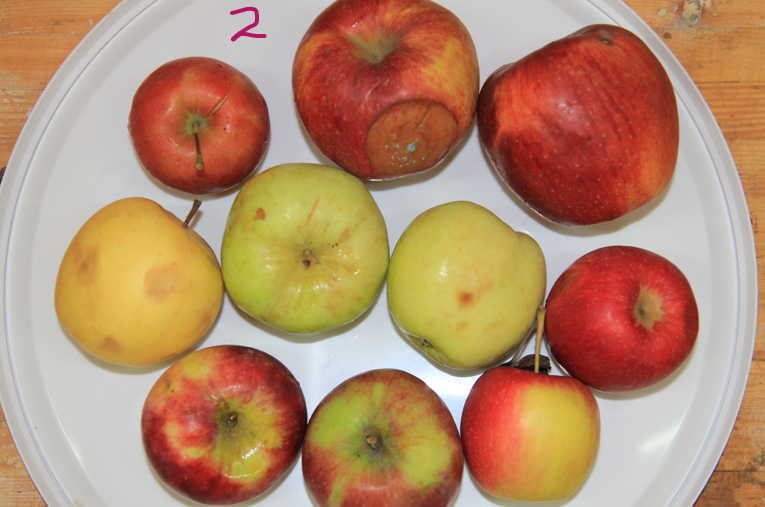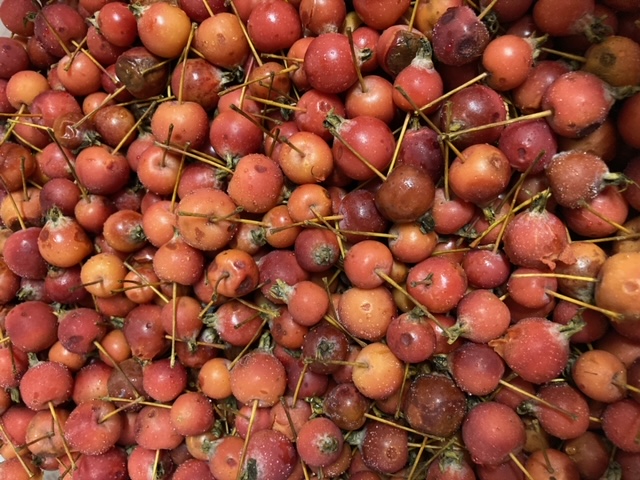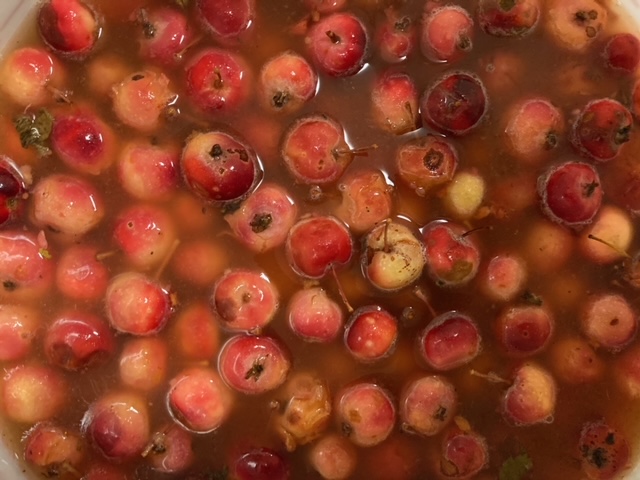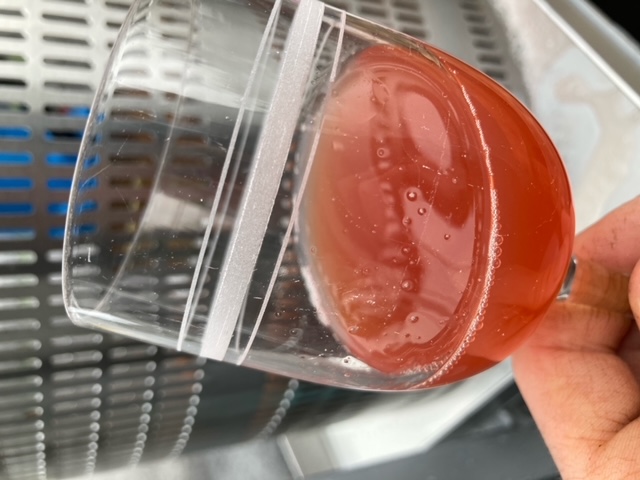Carbonic maceration of crabs (results of home trial)
Jeffrey Lewis
downside perry
Jeffrey Lewis
Id imagine the tannin dropped a lot as well. Did it?
--
--
Visit our website: http://www.ciderworkshop.com
You received this message because you are subscribed to the "Cider Workshop" Google Group.
By joining the Cider Workshop, you agree to abide by our principles. Please see http://www.ciderworkshop.com/resources_principles.html
---
You received this message because you are subscribed to a topic in the Google Groups "Cider Workshop" group.
To unsubscribe from this topic, visit https://groups.google.com/d/topic/cider-workshop/hRS_-5V0FTQ/unsubscribe.
To unsubscribe from this group and all its topics, send an email to cider-worksho...@googlegroups.com.
To post to this group, send email to cider-w...@googlegroups.com.
For more options, visit https://groups.google.com/d/optout.
Claude Jolicoeur
This is a quite interesting experiment! For my part I have never tried anything like that.
However there is a cidery in Quebec, Cidrerie Milton (formely Vergers de la Colline) that does a maceration of Dolgo crabs in order to extract the color from the skin and thus produce a rosé cider. What the cidermaker told me is that they do this maceration at relatively warm temperature (he didn't tell me the temperature however), and after grinding the fruit.
Do you know the Dolgo? It is quite a popular crab here in Quebec, used a lot for making a very tasty deep red jelly. It is very acidic, with TA usually around 25 g/L as malic.
He didn't tell me if this did also reduce the TA of the juice, but it is possible. Nor did he mention if this was done under CO2 atmosphere.
Claude
Jeffrey Lewis
Andrew Lea
Btw it would be better to quote your acids ‘as malic’ rather than ‘as tartaric’ which could mislead people into thinking that there is actually tartaric acid in your apples. Multiply your figures by 0.89 to get the correct value.
www.cider.org.uk
--
--
Visit our website: http://www.ciderworkshop.com
You received this message because you are subscribed to the "Cider Workshop" Google Group.
By joining the Cider Workshop, you agree to abide by our principles. Please see http://www.ciderworkshop.com/resources_principles.html
---
You received this message because you are subscribed to the Google Groups "Cider Workshop" group.
To unsubscribe from this group and stop receiving emails from it, send an email to cider-worksho...@googlegroups.com.
Bartek Knapek
Andrew Lea
Miguel Pereda
El jueves, 2 de noviembre de 2017, 8:41:38 (UTC+1), Bartek Knapek escribió:
I found that even a plain maceration can decrease TA.In my case, after 24h at ~18C, the TA (malic) dropped 1g/L (7,5->6,5).
At 18ºC and with those values of TA, you can think that what makes the TA lower during maceration is the beginning of MLF
woodcarver
If I have time this season I’m going to try to repeat your experiment. You mentioned that you did a control with just air—was did you keep the temperature high?
I don’t have a sauna unfortunately. Going to have to put the apples in a plastic bin and strap on an electric heater.
Jeffrey Lewis
Johan
Cillian Breathnach
--
--
Visit our website: http://www.ciderworkshop.com
You received this message because you are subscribed to the "Cider Workshop" Google Group.
By joining the Cider Workshop, you agree to abide by our principles. Please see http://www.ciderworkshop.com/resources_principles.html
---
You received this message because you are subscribed to the Google Groups "Cider Workshop" group.
To unsubscribe from this group and stop receiving emails from it, send an email to cider-worksho...@googlegroups.com.
To view this discussion on the web, visit https://groups.google.com/d/msgid/cider-workshop/7c92f3d6-9ce8-4d96-93be-4158ad03b6ean%40googlegroups.com.
Johan Strömberg
To view this discussion on the web, visit https://groups.google.com/d/msgid/cider-workshop/CAL%2BpTqT7gprxkO%2B6EEe3Hw5PX%2Bw6kHNOQA2gbGWYoL7ef%3Dx4tA%40mail.gmail.com.
Cillian Breathnach
To view this discussion on the web, visit https://groups.google.com/d/msgid/cider-workshop/9CE8F105-8FB4-4ECC-8A37-B31D40CD2763%40gmail.com.
Claude Jolicoeur
James MacLarnon
radfordgraham333
--
Visit our website: http://www.ciderworkshop.com
You received this message because you are subscribed to the "Cider Workshop" Google Group.
By joining the Cider Workshop, you agree to abide by our principles. Please see http://www.ciderworkshop.com/resources_principles.html
---
You received this message because you are subscribed to the Google Groups "Cider Workshop" group.
To unsubscribe from this group and stop receiving emails from it, send an email to cider-worksho...@googlegroups.com.
Alan Stone
To view this discussion on the web, visit https://groups.google.com/d/msgid/cider-workshop/6131e420.1c69fb81.95690.896c%40mx.google.com.
Ray Blockley
Alan has a point depending on what style of cider you are after.
If you are going to Herefordshire anyway, picking up some bittersweets to experiment with would be interesting for you?
As you have three containers, perhaps one pure Discovery, one a 1:3 bittersweet to Disco. & one a 1:2 bittersweet to Disco blend?
Doing such would help you understand more about the process?
As to bottling, you may find it easier to add the dry sugar to the bulk cider & stir in well before bottling. It makes the sparkle a bit more controllable & you can also experiment with the amount of sparkle.
As always, think safety & avoiding bombs by choice of bottle versus amount of sugar added.
Nottingham UK
--
--
Visit our website: http://www.ciderworkshop.com
You received this message because you are subscribed to the "Cider Workshop" Google Group.
By joining the Cider Workshop, you agree to abide by our principles. Please see http://www.ciderworkshop.com/resources_principles.html
---
You received this message because you are subscribed to the Google Groups "Cider Workshop" group.
To unsubscribe from this group and stop receiving emails from it, send an email to cider-worksho...@googlegroups.com.
To view this discussion on the web, visit https://groups.google.com/d/msgid/cider-workshop/9580316c-c1ba-47e4-87b0-0eb498becfdbn%40googlegroups.com.
Dave Mitchell
Cillian Breathnach
Hi Claude,I suggested we try the technique out for fun really, not expecting much.I’ll do my best to respond to your questions but I’m not at the orchard atm and my notes are there so I’m going from memory…. Here goes——————1 You say you filled a 1000L vessel with apples - I gather these were whole apples and not milled?Yes they were whole apples.2 This is a regular fermentation tank, I suppose hermetically closed with an air lock?We used a 1000L variable capacity vat with an airlock.3 Then you added 75L of juice that you let ferment. It is then the CO2 produced by this fermentation that fills the vessel and chases the O2 out, so the apples are in a CO2 only environment.Yes we added approx 75L of juice then closed it all off. Spontaneous fermentation. We did add some CO2 from a tank too through the entry/sortie at the bottom of the vat but given fluid/gas dynamics Id say there was a lot of mixing doing this. I would think that the majority of the CO2 came from the fermentation and when settled down this heavier CO2 pushed the O2 out the airlock.4 Did that fermentation go to dryness or maybe it is not important.Yes we let it go to dry5 How was the juice that fermented like? Usable for cider?The juice was really tasty. We are currently selling the cider we made from this batch at the orchard and at 2 stores in Québec (La Place Boutique Gourmande and Monde des Bières sur Marie de l’incarnation).6 I suppose you could also simply ferment water and sugar to produce the CO2...this is also an option, as it’s really the CO2 that you want/need.7 So once this is done, how do the apples look like? Are they still firm? Color change? You then simply mill and press them?After a week they had started to show signs of wrinkling.After two I noticed a little bit of browning under the skin on some apples but not many.After three they were old looking. I took a bite out of one and I must say eating a fizzy apple is quite a sensation.At four weeks they were softer to touch. I believe we pressed after 5 but I’ll have to check my notes.
Did you take TA measurements from the same lot of apples with and without this maceration?
Unfortunately I didn’t take TA readings but going by taste alone there was a huge difference in perceived acidity. The macerated batch was much smoother than an example of I fermented under the same conditions but that was made from the same apples that hadn’t been macerated. Apart from acidity the macerated batch was a lot, I repeat A LOT, fruitier than the unmacerated batch. How much of the reduction in TA is due to the technique or due to MLF I can’t say though.—————So from our first test, I’d describe it as a light juice in terms of acidity and tannins, but the polyphenols are definitely at the party in big numbers. For the apple varieties available in N America that are a little light in tanins compared to European varieties I think it’s a technique that has lots of potential. I’ll definitely be doing it again and this time I’m gonna do a lot more too.For anyone wondering about doing it or worrying about messing it up I’d say go for it. It’s a really simple technique and gives fantastic results (from what I can report back on after our initial trial).All the best,CillianLe Verger à Ti-Paul, Québec
--
--
Visit our website: http://www.ciderworkshop.com
You received this message because you are subscribed to the "Cider Workshop" Google Group.
By joining the Cider Workshop, you agree to abide by our principles. Please see http://www.ciderworkshop.com/resources_principles.html
---
You received this message because you are subscribed to the Google Groups "Cider Workshop" group.
To unsubscribe from this group and stop receiving emails from it, send an email to cider-worksho...@googlegroups.com.
--To view this discussion on the web, visit https://groups.google.com/d/msgid/cider-workshop/7a9ac544-386b-479f-87a6-d4b26badeebbn%40googlegroups.com.
Cillian Breathnach.
Cillian Breathnach
--
--
Visit our website: http://www.ciderworkshop.com
You received this message because you are subscribed to the "Cider Workshop" Google Group.
By joining the Cider Workshop, you agree to abide by our principles. Please see http://www.ciderworkshop.com/resources_principles.html
---
You received this message because you are subscribed to the Google Groups "Cider Workshop" group.
To unsubscribe from this group and stop receiving emails from it, send an email to cider-worksho...@googlegroups.com.
To view this discussion on the web, visit https://groups.google.com/d/msgid/cider-workshop/7a9ac544-386b-479f-87a6-d4b26badeebbn%40googlegroups.com.
Jeffrey Lewis
You received this message because you are subscribed to a topic in the Google Groups "Cider Workshop" group.
To unsubscribe from this topic, visit https://groups.google.com/d/topic/cider-workshop/hRS_-5V0FTQ/unsubscribe.
To unsubscribe from this group and all its topics, send an email to cider-worksho...@googlegroups.com.
To view this discussion on the web, visit https://groups.google.com/d/msgid/cider-workshop/CAL%2BpTqToEmmCBJP5bKi6725%2Body%2BT7rBgxhQuKSFTbAvHGc%3DOQ%40mail.gmail.com.
Cillian Breathnach
To view this discussion on the web, visit https://groups.google.com/d/msgid/cider-workshop/F1B1D0AE-C46F-4611-96EA-7D2DDBDC3BFC%40gmail.com.
Claude Jolicoeur
Cillian Breathnach
--
--
Visit our website: http://www.ciderworkshop.com
You received this message because you are subscribed to the "Cider Workshop" Google Group.
By joining the Cider Workshop, you agree to abide by our principles. Please see http://www.ciderworkshop.com/resources_principles.html
---
You received this message because you are subscribed to the Google Groups "Cider Workshop" group.
To unsubscribe from this group and stop receiving emails from it, send an email to cider-worksho...@googlegroups.com.
To view this discussion on the web, visit https://groups.google.com/d/msgid/cider-workshop/af52ef04-dd0a-48d3-80a5-5872742ce218n%40googlegroups.com.
Courtney Meier
Based on the interesting discussion and results presented so far, I thought I would experiment with carbonic maceration and some Dolgo-type crabapples that grow abundantly around Boulder where I live. My youngest son and I collected about 3 bushels from some local trees on 2021-09-12, and I then did the following:
- Put 50% of the apples into two 30 L buckets; buckets were both full. The other 50% I pressed for a wild ferment: Initial juice SG was 1.094; initial juice TA was 26.5 g/L MAE; pH was 2.8 units.
- I then poured 1 L Kirkland pasteurised apple juice into each bucket (2 L total juice added to apples in buckets).
- Activated a partial packet of Lalvin D47 in 1 L Kirkland juice, let sit at room temp until foamy (2-3 h). Not sure why, but I didn't measure and record how much yeast mass I used. From this active yeast suspension, I then added 500 mL to each bucket and sealed the lids. Basement temperature was 18-21 ˚C.
- Airlocks on the buckets began bubbling within several hours, indicating a CO2-rich environment built up pretty quickly.
- On 2021-09-20, I checked the buckets and discovered that the crabapples had lost all their structure and had turned to mush, releasing quite a bit of their juice in the process. A good deal more of the juice had begun to ferment than I had anticipated.
- Because the juice that came from the crabapples now covered about 50% of the apples in each bucket, I decided to pass everything in the buckets through the rack and cloth press. Apples did not need grinding - I loaded them directly into the press. After pressing, I found that: SG was 1.071; juice TA was 23.7 g/L MAE; pH was 2.9 units. I added Pectic Enzyme per manufacturer instructions, sealed the lid, and let sit overnight.
- I racked today (2021-09-21) because the fermentation was going very quickly - much faster than desired. I didn't measure the FSU but bubbles through the airlock were one right after the other. I'll rack again tomorrow and measure the SG. With only a modest reduction in acid, I am now hoping I can slow the fermentation down so that I can retain some sugar to balance the exceptional acid. If that doesn't work, I will have to use this juice as a small portion of a blend that needs acid.
Courtney Meier | Plant Ecologist | Cider Hobbyist | Boulder, CO
Johan Strömberg
You received this message because you are subscribed to a topic in the Google Groups "Cider Workshop" group.
To unsubscribe from this topic, visit https://groups.google.com/d/topic/cider-workshop/hRS_-5V0FTQ/unsubscribe.
To unsubscribe from this group and all its topics, send an email to cider-worksho...@googlegroups.com.
To view this discussion on the web, visit https://groups.google.com/d/msgid/cider-workshop/8d02ed37-dcf9-493e-ac33-a33542919b5an%40googlegroups.com.
Cillian Breathnach
To view this discussion on the web, visit https://groups.google.com/d/msgid/cider-workshop/CAFFD97sRQ_X6RE%2BYaCKDxx42N0%3D-Uw3zk2A9tS_nbN5mnYdgPQ%40mail.gmail.com.
Claude Jolicoeur
Based on the interesting discussion and results presented so far, I thought I would experiment with carbonic maceration
Zacharias Erså
--
--
Visit our website: http://www.ciderworkshop.com
You received this message because you are subscribed to the "Cider Workshop" Google Group.
By joining the Cider Workshop, you agree to abide by our principles. Please see http://www.ciderworkshop.com/resources_principles.html
---
You received this message because you are subscribed to the Google Groups "Cider Workshop" group.
To unsubscribe from this group and stop receiving emails from it, send an email to cider-worksho...@googlegroups.com.
To view this discussion on the web, visit https://groups.google.com/d/msgid/cider-workshop/f1b0e867-1978-4a97-9709-c6e402565f65n%40googlegroups.com.
Courtney Meier
Zacharias Erså
@johan - Yes, I suspect that the temperat was too low and the duration too short for my trial. I ended up checking on them early because I was concerned the Dolgos might completely break down and I would therefore just end up fermenting the apples whole along with all the juice that was released, which is pretty much what seems to have happened. When I scooped them out of the buckets they were complete mush, and the SG of the juice I pressed was 0.025 points lower than the initial juice.
To view this discussion on the web, visit https://groups.google.com/d/msgid/cider-workshop/300b7cc8-ca4f-435c-99ec-4bf0dbd07ca7n%40googlegroups.com.
Bartek Knapek
I wonder - why is it called "maceration"? Woudn't "carbonic
sweatening" be more accurate?
Maceration involves soaking, and in the cider making it refers to
storing crushed apples for a period of time.
I have done a small trial as well.
A mix of Antonovka, Eliza, McIntosh, Jonagold, Sisi Red and some
early Reinette.
1. crushed and pressed immediately -> SG 1.044, TA 8,7 malic
2. two weeks in CO2 @20C -> SG 1.044, TA 6
3. two weeks in CO2 @35C -> SG 1.040, TA 4, ~0,6%vol (ebulliometer)
4. two weeks in air atm. @35C -> SG 1.046, TA 2.3
In #4 apples became overripe (but did not rot, to my surprise),
while in #3 they started to ferment slightly inside:


Johan Strömberg




I wonder - why is it called "maceration"? Woudn't "carbonic sweatening" be more accurate?
Maceration involves soaking, and in the cider making it refers to storing crushed apples for a period of time.
I have done a small trial as well.
A mix of Antonovka, Eliza, McIntosh, Jonagold, Sisi Red and some early Reinette.
1. crushed and pressed immediately -> SG 1.044, TA 8,7 malic2. two weeks in CO2 @20C -> SG 1.044, TA 6
3. two weeks in CO2 @35C -> SG 1.040, TA 4, ~0,6%vol (ebulliometer)
4. two weeks in air atm. @35C -> SG 1.046, TA 2.3
In #4 apples became overripe (but did not rot, to my surprise), while in #3 they started to ferment slightly inside:
<lccbinijnanhokjl.png>
Apples answered to treatments very differently - Antonovkas (middle) changed the most, while Reinettes looked rather ambivalent (but went down in acidity as well, to taste).
In #2 apples did not show much change, but surprisingly here some started to rot:
<jhomllcoijpckeem.png>
Now the next questions is: how these teratments will influence other properties of ciders. Just started to ferment...
//Bartek
--
--
Visit our website: http://www.ciderworkshop.com
You received this message because you are subscribed to the "Cider Workshop" Google Group.
By joining the Cider Workshop, you agree to abide by our principles. Please see http://www.ciderworkshop.com/resources_principles.html
---
You received this message because you are subscribed to the Google Groups "Cider Workshop" group.
To unsubscribe from this group and stop receiving emails from it, send an email to cider-worksho...@googlegroups.com.
To view this discussion on the web, visit https://groups.google.com/d/msgid/cider-workshop/38e69b9e-7015-5289-8082-9d92694b1333%40knapek.pl.
Eric Tyira
To view this discussion on the web, visit https://groups.google.com/d/msgid/cider-workshop/CBED394D-B5BD-4362-86DE-73CD105D0D09%40gmail.com.
Andrew Lea
www.cider.org.uk
Claude Jolicoeur
I had 16 kg of apples from a natural/wild seedling tree that tasted fairly acidic from eating a sample apple.I filled a 30L pail with 12.5 kg of apples and pressed the rest of the apples on the 13th of September.The juice obtained was at SG 1.046 and TA 6.3 as malic - not as acidic as anticipated from tasting an apple, but I think the low SG contributed to this perception. I had a thought I should get more acidic apples to conduct this test, but as everything was ready I decided to go ahead anyway.I took 2.4L from the pressed juice, inoculated it with yeast and introduced it in the pail.
jeff.k...@gmail.com
Love Lindholm
Could you please tell what variety those apples were? I also use Swedish apples :-)
Also, was the pressure in the keg actually 0.5 bar, i.e., half of normal atmospheric pressure? Or does 0.5 bar here indicate 0.5 bar above atmospheric pressure, so that the pressure inside the keg was 1.5 bar?
Best
Love
